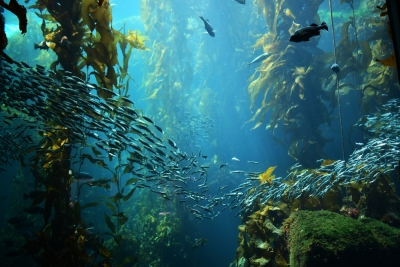
A type of algae, kelp is crucial for thriving ecosystems the world over. However, kelp forests are shrinking. But, why? Let’s find out
Most types of seaweed or marine algae grow along the coasts in shallow waters, where they can attach themselves to rocks, shells, or the sea floor. A root-like part called holdfast anchors them firmly and prevents them being washed away by strong waves or currents. A soft, flexible stem-like frond with outgrowths similar to leaves emerges from the holdfast. Though they carry out photosynthesis, algae are not plants as they don’t have true roots, stems, leaves, or flowers. Marine algae can be green, brown, or red in colour. Red algae are delicate and feathery and prefer warm tropical seas. Small green algae are found everywhere in shallow waters. Brown algae called giant kelp grow in cool waters at depths ranging from 15 to 40 mt.
Extraordinary ecosystem
A kelp forest is one of the most valuable and productive: ecosystems on Earth. Kelp forests are found all over the world-the west coasts of North and South America, the southern tip of Africa and Australia, and off islands near Antarctica. In North America, kelp forests are found on the Pacific Coast from Alaska to California. A forest of kelp is home to a variety of creatures. They live and forage for food among its broad blades. The kelp provides shelter not only from predators. but also from storms. Mammals and birds that thrive in kelp forests include seals, sea lions, whales, sea otters, gulls, terms, egrets, and herons. Sea otters have an especially beneficial bond with kelp. Mother otters wrap their babies in kelp to keep them from drifting away while they go hunting. Adult otters also find the dense kelp canopies a secure place to snooze. The otters return the favour by eating sea urchins that dine on kelp. Kelp forests can shoot up in no time, growing up to 30 cm a day. Some species attain heights of over 45 mt!
Kelp farming is a big part of the billion-dollar global seaweed-farming industry. Kelp renders sea water less acidic. This enables kelp farmers to raise shellfish, which require low acidity. Kelp and mussels are grown on floating ropes, which also support baskets of scallops and oysters. One kelp farm can produce 40 metric tonnes of kelp and a million shellfish per hectare per year! As with other species of seaweed, kelp is used in many products,) including shampoos and toothpastes, as well as a wide range of foods such as salad dressings, puddings, cakes, dairy products, and ice cream. It is also employed in pharmaceuticals and in the manufacture of fireproof and waterproof textiles.
Urchin attack
The waters off the coast of northern California are home to lush forests of bull kelp. Since 2013, the population of purple sea urchins that feast on the kelp, has exploded, destroying almost 90 % of the kelp forest. Sea stars prey on purple urchins and keep their numbers in check. However, a mysterious disease killed off huge numbers of sea stars, leaving sea urchins to thrive. Sea snails (called red abalone) and red sea urchins, both of which are raised for meat and feed on bull kelp, died from starvation. Commercial red sea urchin and red abalone fisheries located on America’s northwestern coast have closed down as a result.
Fact file
• Kelp forests are the ocean’s lungs just as trees are the Earth’s lungs. They absorb carbon dioxide and give out oxygen.
• Warming seas along the Australian coast have wiped out huge swathes of kelp forest.
•Extremely hot weather is harmful to kelp forests. Strong storms can wipe out large areas by uprooting the plants from the sea floor.
• There are 18 species of edible kelp, including kombu widely used in Japanese cuisine.
•Kelp is rich in calcium and Vitamin K.
Picture Credit : Google




